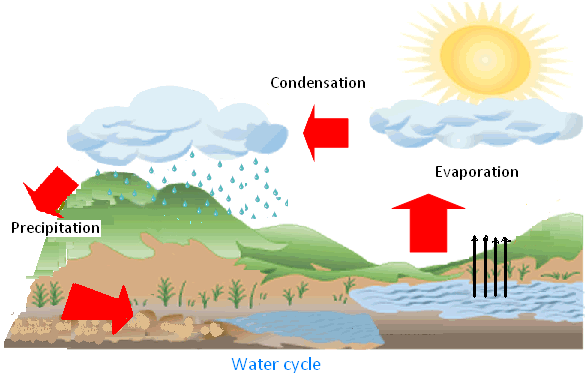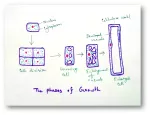Forms of Water
What are the different forms of water?
Water can have three forms – solid, liquid and gas.
Usually it is a liquid and we can pour it from a bottle. However it can change into other forms. When it freezes it becomes ice. Ice is a hard solid. If the ice is left outside, it will melt and become water again. When we heat water in a kettle, it gets warm. After some time it boils. The boiling water changes into steam or water vapour. If a steel plate is held in front of the kettle, the steam cools. It changes back into droplets of water.
Ice, steam and water are the different forms of the water. Ice is the solid form of water. The water we use is the liquid form of water and steam is the gaseous form of water. Steam is water in the form of gas. It is also called water vapour.
Where is water found in nature?
Water comes down from clouds as rain. The snow from the mountains melts and flows into rivers. We can see water in small ponds and bigger lakes. The water in a river is always moving. It flows into the sea. The water in the sea is salty.
The Sun's heat changes a part of 'the water in lakes, rivers and the sea into water vapour. All this water vapour goes into the air. On high mountain tops, it is very cold. The water vapour in the air freezes. It is found on the ground as snow.
In summer, the snow melts into water. This water flows into rivers. The rivers carry it to the sea. When it rains, water fills up rivers and ponds. It also sinks into the ground. People dig wells to take out this water. They use water from rivers and lakes for drinking.
An explanation on water cycle along with the pictures and diagrams showing the relation between evaporation, condensation and precipitation.
What is water cycle?
When the sun shines on rivers, lakes or seas the heat of the sun changes some of the water into vapour. The change of water into water vapours called evaporation.
This water vapour goes up into the air and forms tiny drops of water on meeting cool air. This is called condensation. Many such drops of water together form a cloud.
Precipitation occurs when the clouds become heavy with water, it falls down to the earth as rain, snow, hail or sleet.
The rainwater again goes into rivers, lake, streams, etc. Thus, we have learnt how the water cycle works and how the repetition of water cycle in nature goes on and on.
From Forms of Water to HOME PAGE
Recent Articles
-
Explain about Growth in Plants |Definition of Growth & Differentiation
Feb 27, 25 02:07 PM
Growth is a permanent increase in length or volume of an organism that brought upon by an increase in its dimensions due to synthesis of new protoplasmic material. -
Definition of Respiratory Quotient | calculation | Application | Plant
Dec 02, 24 12:09 AM
Definition of respiration quotient- the ratio of the carbon-dioxide evolved to that of the oxygen consumed by a cell, tissue, plants or animals in a given time is called respiratory quotient. It is us… -
Amphibolic Pathway | Definition | Examples | Pentose Phosphate Pathway
Jun 06, 24 10:40 AM
Definition of amphibolic pathway- Amphibolic pathway is a biochemical pathway where anabolism and catabolism are both combined together. Examples of amphibolic pathway- there are different biochemical… -
Respiratory Balance Sheet | TCA Cycle | ATP Consumption Process
Feb 18, 24 01:56 PM
The major component that produced during the photosynthesis is Glucose which is further metabolised by the different metabolic pathways like glycolysis, Krebs cycle, TCA cycle and produces energy whic… -
Electron Transport System and Oxidative Phosphorylation | ETC |Diagram
Feb 04, 24 01:57 PM
It is also called ETC. Electron transfer means the process where one electron relocates from one atom to the other atom. Definition of electron transport chain - The biological process where a chains…





New! Comments
Have your say about what you just read! Leave me a comment in the box below.